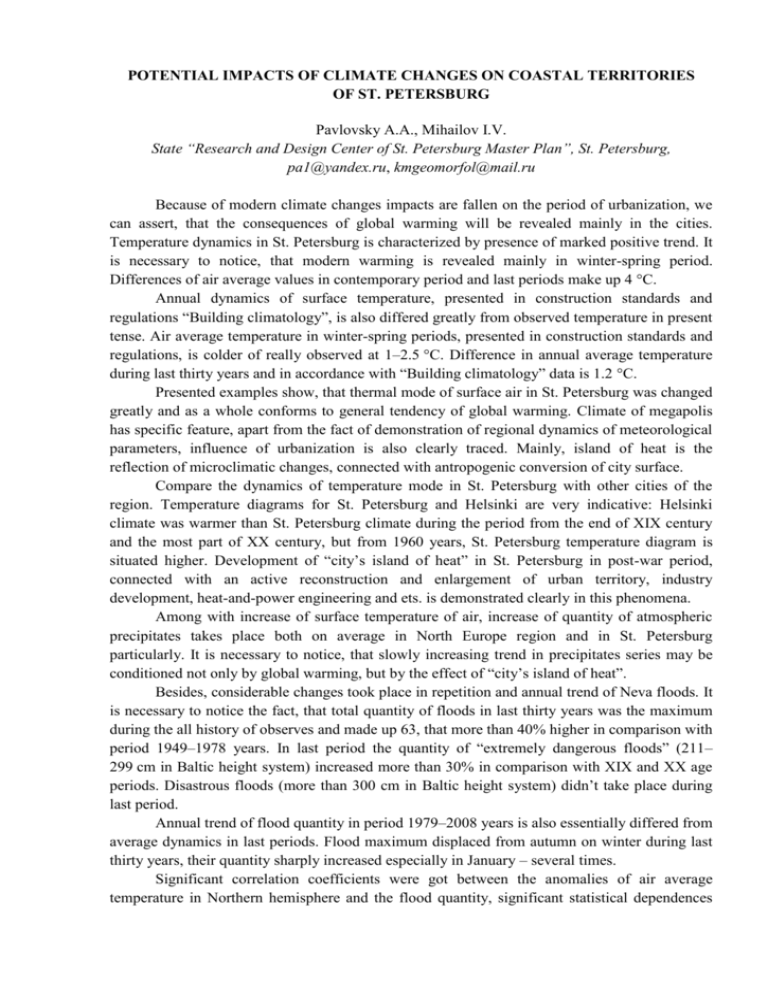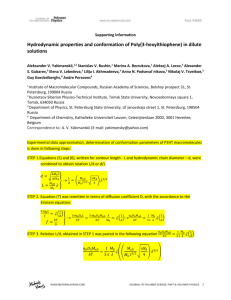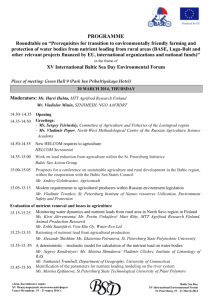Pavlovsky А.А., Mihailov IV
advertisement

POTENTIAL IMPACTS OF CLIMATE CHANGES ON COASTAL TERRITORIES OF ST. PETERSBURG Pavlovsky А.А., Mihailov I.V. State “Research and Design Center of St. Petersburg Master Plan”, St. Petersburg, pa1@yandex.ru, kmgeomorfol@mail.ru Because of modern climate changes impacts are fallen on the period of urbanization, we can assert, that the consequences of global warming will be revealed mainly in the cities. Temperature dynamics in St. Petersburg is characterized by presence of marked positive trend. It is necessary to notice, that modern warming is revealed mainly in winter-spring period. Differences of air average values in contemporary period and last periods make up 4 °С. Annual dynamics of surface temperature, presented in construction standards and regulations “Building climatology”, is also differed greatly from observed temperature in present tense. Air average temperature in winter-spring periods, presented in construction standards and regulations, is colder of really observed at 1–2.5 °С. Difference in annual average temperature during last thirty years and in accordance with “Building climatology” data is 1.2 °С. Presented examples show, that thermal mode of surface air in St. Petersburg was changed greatly and as a whole conforms to general tendency of global warming. Climate of megapolis has specific feature, apart from the fact of demonstration of regional dynamics of meteorological parameters, influence of urbanization is also clearly traced. Mainly, island of heat is the reflection of microclimatic changes, connected with antropogenic conversion of city surface. Compare the dynamics of temperature mode in St. Petersburg with other cities of the region. Temperature diagrams for St. Petersburg and Helsinki are very indicative: Helsinki climate was warmer than St. Petersburg climate during the period from the end of XIX century and the most part of XX century, but from 1960 years, St. Petersburg temperature diagram is situated higher. Development of “city’s island of heat” in St. Petersburg in post-war period, connected with an active reconstruction and enlargement of urban territory, industry development, heat-and-power engineering and ets. is demonstrated clearly in this phenomena. Among with increase of surface temperature of air, increase of quantity of atmospheric precipitates takes place both on average in North Europe region and in St. Petersburg particularly. It is necessary to notice, that slowly increasing trend in precipitates series may be conditioned not only by global warming, but by the effect of “city’s island of heat”. Besides, considerable changes took place in repetition and annual trend of Neva floods. It is necessary to notice the fact, that total quantity of floods in last thirty years was the maximum during the all history of observes and made up 63, that more than 40% higher in comparison with period 1949–1978 years. In last period the quantity of “extremely dangerous floods” (211– 299 cm in Baltic height system) increased more than 30% in comparison with XIX and XX age periods. Disastrous floods (more than 300 cm in Baltic height system) didn’t take place during last period. Annual trend of flood quantity in period 1979–2008 years is also essentially differed from average dynamics in last periods. Flood maximum displaced from autumn on winter during last thirty years, their quantity sharply increased especially in January – several times. Significant correlation coefficients were got between the anomalies of air average temperature in Northern hemisphere and the flood quantity, significant statistical dependences between the index of Northern Atlantic Oscillation (NAO) and the flood quantity, and also between the anomalies of air average temperature in Northern hemisphere and index NAO. Contemporary climate changes practically touch all fields of man activity and environment components. In this connection the getting of proved estimations of possible consequences of global warming and elaboration of adaptation steps for the stable development of the territories of the big cities, especially megapolises is specially urgent. Change, regarding the duration of heating season, will result in reduction of the costs on heating, at the same time it is forecasted the increase of energy consumption on conditioning in warm season. Forecasted decrease of ice season in Gulf of Finland and on Neva River on 1–2 months and also decrease of sea ice capacity can essentially extend the working period of Volga–Baltic Waterway and sea ports. Impact on hydrological characteristics and ecosystem of Gulf of Finland with coastal territory may be the major consequence of climate changes for St. Petersburg. The problem of possible increase the level of Baltic Sea attracts attention of research groups of region countries. Calculated estimations show that the most increase of sea level will be in south and east part of Baltic. In case of realization of “positive” scenario the increase of sea level in St. Petersburg region at the end of XXI age will be 37 centimeters. In case of realization of “negative” scenario the increase of level of east part of Gulf of Finland will be 84 centimeters (http://gsf.fi/projects/seareg/). At average long-term increase of level of Gulf of Finland on one meter, flood area will be 1362 hectares: in Primorsky district – 816 hectares, in Kronshtadsky district – 259 hectares, in Kurortny district – 223 hectares, in Petrodvordtsovy district – 64 hectares. Coastal territories of great natural and historical and cultural importance, including valuable recreation resource of the northern coast of Gulf of Finland – beaches of Kurortny district will be fallen within flood area. Experience of researches, performed in frames, both IPCC and other large international and national projects earnestly shows, that the problem of climate changes impact on first-rate megapolises is one of the key problem of contemporary science about climate change. Phenomenon of global warming must be taken into account during the development of documents of territory planning, master plans, of modern megapolises.







